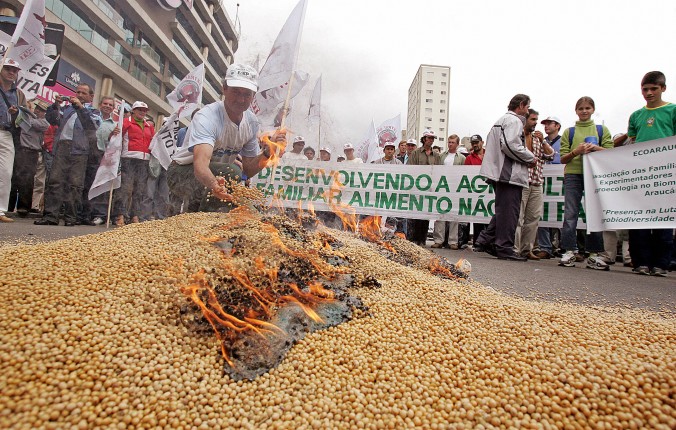Monsanto’s Intacta RR2 PRO soybeans are outperformed by non-GM soybeans in the major soy-producing regions of Brazil, according to a new scientific study reported in Valor Econômico.

Source: Valor Econômico pratoslimpos.org.br
Translated by GM Watch: www.gmwatch.org
Intacta soybeans contain genes for tolerance to glyphosate herbicide and a Bt insecticidal toxin.
According to the study, which was carried out by the Center for Advanced Studies in Applied Economics (Cepea) of ESALQ at the University of São Paulo, Intacta soybeans showed an average yield close to that of Roundup Ready (RR) soybeans, the first generation of Monsanto GM seeds. However, both GM crops were outperformed by conventional (non-GM) soybeans, which yielded better and were more profitable for farmers.
The yield performance ranking was as follows:
Non-GM soy: 57.1 bags per hectare (a bag is 60 kg)
Intacta RR2 PRO GM soy (RR2): 54.8 bags per hectare
Roundup Ready GM soy: 52.4 bags per hectare
The profitability ranking was as follows:
Non-GM soy: R$ (Brazilian Real) 369/hectare
Intacta RR2 PRO GM soy: R$ 333/ha
Roundup Ready GM soy: R$ 128/ha
The survey, based on technical field visits and consultation with universities, took into account data from 258 producers and consultants in 27 municipalities of 10 Brazilian states: Mato Grosso, Mato Grosso do Sul, Goias, Parana, Santa Catarina, Rio Grande do Sul, Minas Gerais, Maranhão, Piauí, and Tocantins, during the season 2014/15.
The municipalities were divided into three groups, according to types of soybean planted: non-GMO soy, Roundup Ready GM soy, and Intacta RR2 PRO GM soy.
Non-GMO soybeans stand out on yield
Regarding productivity, in the 16 municipalities surveyed where Intacta soybeans were planted, average yield was 54.8 bags per hectare. This was slightly above the 52.4 bags/ha in the 25 municipalities that planted the older Monsanto product, Roundup Ready GM soy. But the performance of non-GMO soybeans stood out at 57.1 bags per hectare, although this average came from a restricted sample of six municipalities.
There is a significant irony in the fact that in terms of planting area, non-GM soybeans are being squeezed out by lesser-performing GM varieties. In 2010 Monsanto, which controls the seed market in Brazil, brought in the “85/15 rule”, which meant that farmers could only buy 15% non-GM seed – the other 85% had to be GM. So even those farmers who wanted to grow non-GMO soybeans often had trouble getting hold of seed.
Higher seed costs, lower profitability for GM soy
The new study found that Intacta GM seed is nearly twice as expensive as non-GM seeds. The average seed cost in the municipalities where Intacta is grown is R$ 407 per hectare, up from R$ 227 in municipalities growing Roundup Ready GM soy and R$ 214 for non-GMO soybeans.
On the other hand, when comparing the costs of insecticides, municipalities growing Intacta soy had average expenditure of R$ 106 per hectare, down from R$ 213 for Roundup Ready GM soy, and R$ 253 for non-GMO soy.
But according to Mauro Osaki, the researcher at Cepea who led the research, it is “clear” that, due to adverse weather conditions such as drought or excessive rain and misuse of technologies, spending on pesticides is increasing for Intacta soybeans and this is not accompanied by gains in productivity. “Theoretically, Intacta is supposed to eliminate the use of pesticides, but with a higher incidence of pests such as the Soybean Looper moth, for example, and the lack of new products, the effect is the opposite,” he says.
Thus the overall profitability of non-GMO soybeans is slightly above that of Intacta. Total net profitability obtained in the municipalities where non-GMO soybeans were planted was R$ 369.1 per hectare on average in the 2014/15 harvest, higher than the R$ 333.6 figure for Intacta. Profitability for Roundup Ready GM soy lagged well behind at R$ 127.9 per hectare.
When contacted, Monsanto said through a spokesperson: “Rapid growth in the adoption of Intacta RR2 PRO technology shows that farmers are receiving the benefits of the technology in the field.” Between the 2013/14 and 2014/15 cropping seasons, the area planted with these soybeans in Brazil jumped from 13,000 to 55,000 hectares.



















Finally. This article gives me hope that farmers may be able to fight back. Regardless of what all Monsanto’s toxicity is doing to our dear Mother Earth, by exposing the costs/yields maybe the farmers will hold out for a more natural seed. See a great eye-opener: The Future of Food, by Debra Koons Garcia www.thefutureoffood.com/onlinevideo.html
I have been a foe of GMO’s for as long as I can remember. I’m a very healthy 76 yr. old.and I owe it mostly to eating organically for the most part.
Thank you for your site!
Maddy